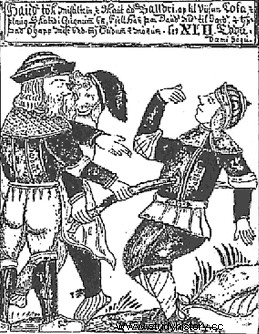
LIn Scandinavian mythology, Baldr (Old Icelandic Baldr, Latin Balderus) was one of the Ases, the son of Odin and Frigg. His wife is Nanna, and their son Forseti. It is described as "so beautiful in appearance and so clear that it is luminous, and there is a plant so white that it is named after Baldr's eyelash." It is the whitest of all plants, and that gives us an idea of its beauty, both in hair and in body. He is the wisest of the Ases and the most eloquent and most merciful, but it is one of his peculiarities that none of his decisions are accomplished. (Snorri Sturluson, Prose Edda 2:22.) His domain is Breidablik, which is in heaven (or in Sweden, according to the Ynglinga Saga), in a land from which evil is banished.
The prologue to the Prose Edda equates him with Bældæg, one of the sons of Woden (=Odin), who reigned over Westphalia and was the ancestor, according to the Anglo-Saxon Chronicle, of the royal houses of Wessex and Northumbria .
Baldr's Death
The essential myth associated with Baldr is the account of his death, told in chapter 49 of the Gylfaginning.
Baldr began to have ominous dreams of his own death, which frightened the Aesir. Odin traveled to Niflheim, to interrogate the soul of a dead prophetess (as told in the Eddic poem Baldrsdraumar), who revealed to him the fate of her son. Frigg then made all the elements, minerals, plants, animals of creation swear that they would never harm Baldr, who thereby became invulnerable. The Aesir had fun throwing all kinds of projectiles at Baldr and hitting him with all kinds of objects, and still seeing him unscathed.
But Loki resented this, and, taking the form of a woman, got Frigg to admit that she had forgotten to ask the mistletoe to take the oath, so frail and young did this plant look. Loki took a stick of mistletoe, gave it to Höd, the blind god, and guided his arm to throw it at Baldr, who was stabbed and immediately died.
Dismay among the Aesir was great, and Hermod volunteered to travel to the Kingdom of Hel to secure Baldr's return for ransom. Hermod mounted Sleipnir and set off.
Meanwhile, the Aesir celebrated the funeral of Baldr, whom they wanted to cremate on his ship Hringhorni. But the ship refused to leave the mainland. They brought from Jötunheim a giantess named Hyrrokkin to move him, who succeeded so well that the earth shook and flames were born from the friction of the logs, which angered Thor. He would have killed her if the Aesir had not begged him to spare her life. Baldr's body was placed on the ship, and his wife Nanna died of grief. She was placed at the stake by his side. Thor consecrated the pyre with his hammer Mjöllnir, but a dwarf named Lit ran ahead of him, and Thor kicked him into the flames.
Many were present at Baldr's cremation, as the Gylfaginning says:“First Odin, accompanied by Frigg, the Valkyries, and his ravens; while Freyr drove a boar-drawn chariot called Gullinbursti or Slidrugtanni; Heimdall rode a horse called Gulltopp, and Freyja her cats. Also present were a large troop of frost giants and mountain giants. Odin placed on the pyre a bracelet called Draupnir which had, from that day, the property of producing eight bracelets of the same weight every nine nights. Baldr's horse was led to the stake, with all its trappings. (Snorri Sturluson, Prose Edda 2:49.)
For his part, Hermod rode nine nights and reached the river Gioll, whose bridge, all in gold, was guarded by the virgin Modgud. She inquired about his identity and his lineage, and asked him what he was doing in Hel when he was not dead. Hermod revealed to him that he had come to fetch Baldr, and Modgud confirmed that he had indeed passed through the bridge.
Hermod rode to Hel, jumped the gates mounted on Sleipnir and found his Baldr seated in the place of honor. The next day, he begged Hel to allow Baldr to return with him. She declared that she would accept if everything in the world, living or dead, would mourn Baldr, but if any object refused to do so, she would keep him forever.
Then Baldr gave the Draupnir bracelet to Hermod, to return it to Odin, and Nanna gave him a linen robe and other gifts for Frigg, and a ring for Fulla. Hermod then returned to Ásgard.
Then the Aesir sent messages to the four corners of the universe, asking everything to mourn Baldr, which all did, except for a giantess called Thokk, who is presumed to have been Loki in disguise. As a result, Baldr remained in Hel.
Other Myths
* When she had to choose a husband among the Aesir, Skadi hoped to find Baldr, but it was Njörd that she got.
* Vali, another of Odin's sons, avenges Baldr's murder by killing Höd.
* In the Gesta Danorum, Baldr is described as the unhappy and rejected lover of Nanna, jealous of his rival Hother (=Höd). Baldr was invulnerable, but Hother defeated him with the only weapon that could kill him, Miming's sword.
* At the end of time, when the world will be reborn after Ragnarök, Baldr will return from Hel to dwell there. the Völuspa tells us that Baldr will return with his brother Höd. The grass will be reborn and all the sons and daughters of the surviving gods will take refuge around him on the Yggdrasil.
* Christians relied heavily on Baldr's resemblance to Jesus Christ (two martyrs, pure, who will be reborn after the apocalypse) in order to convert the Nordic peoples.
